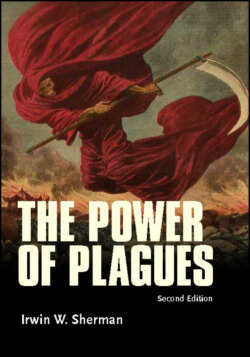Читать книгу The Power of Plagues - Irwin W. Sherman - Страница 35
A Look Back
ОглавлениеAt the beginning of the 12th century the European population grew quickly after achieving relatively stable numbers during the early Middle Ages. One of the reasons for the unchanging numbers of people was poor harvests and famine, but with the introduction of new crops, windmills, waterwheels, horse collars, and the mold-board plow, agricultural production increased. Money instead of barter began to be used in trade, and with this prosperity new towns grew, and so did the population. But by the 13th century there was ushered in a sustained period of cold winters and rainy summers. Agriculture could not keep up with the population rise, and over the next century famines occurred every few years. The result was poverty and misery, especially in the crowded and filthy cities.
The second pandemic occurred from 1346 to 1353 and probably originated from the steppes of central Asia, where it was epidemic among small mammals such as marmots and gerbils. Plague spread westward along the trade routes to enter Europe. An outbreak occurred along the Volga River, from where it spread west to the Don River and then down to the Black Sea. By 1347 there were outbreaks in the port cities of Kaffa (present-day Feodosia), Constantinople (present-day Istanbul), and Genoa, and as plague continued to move by ship, it spread via North Africa to Spain by 1348. By this time it had already reached central Europe, including France, Germany, Switzerland, Austria, and even as far as Great Britain. From there it traveled to Scandinavia aboard a ship from London that docked in Bergen in 1349, carrying crew, wool cargo, and plague. By 1351 it was in Poland, and when in 1352 it reached Russia, plague had completed its circuit and a deadly noose had been secured around Europe. In its path the Black Death killed an estimated 17 million to 28 million Europeans, representing ~30 to 40% of the population at the time.
In 1358, Agnolo di Tura, a citizen of Siena, described the situation:
Father abandoned child; wife, husband; one brother, another; for this illness seemed to strike through the breath and sight. And so they died. And no one could be found to bury the dead for money or for friendship … and in many places in Siena great pits were dug and piled deep with huge heaps of dead. … And I, Agnolo di Tura, called the Fat, buried my five children with my own hands and so did many others likewise. And there were also so many dead throughout the city who were so sparsely covered with earth that the dogs dragged them forth and devoured their bodies.
The short-term effect of plague was shock and fear. Panic and fright broke the continuity of the existing economic structure and disrupted the routines of work and service. People were terrified, and they deserted the cities and towns. In consequence, communities were thrown into chaos. But the Black Death also had its positive aspects: it contributed to technological advances through the invention of labor-saving devices, as well as a reevaluation of Galenic medicine, and with so many dead the value of labor rose sharply, resulting in greater prosperity among the working survivors.
